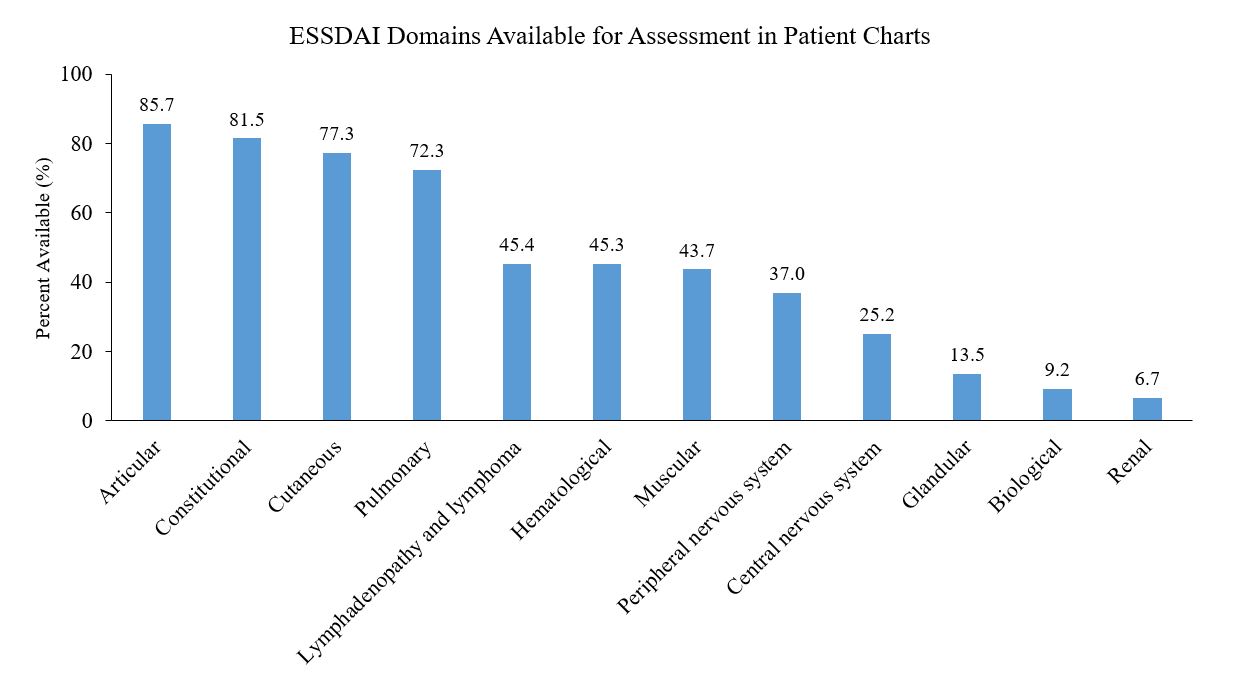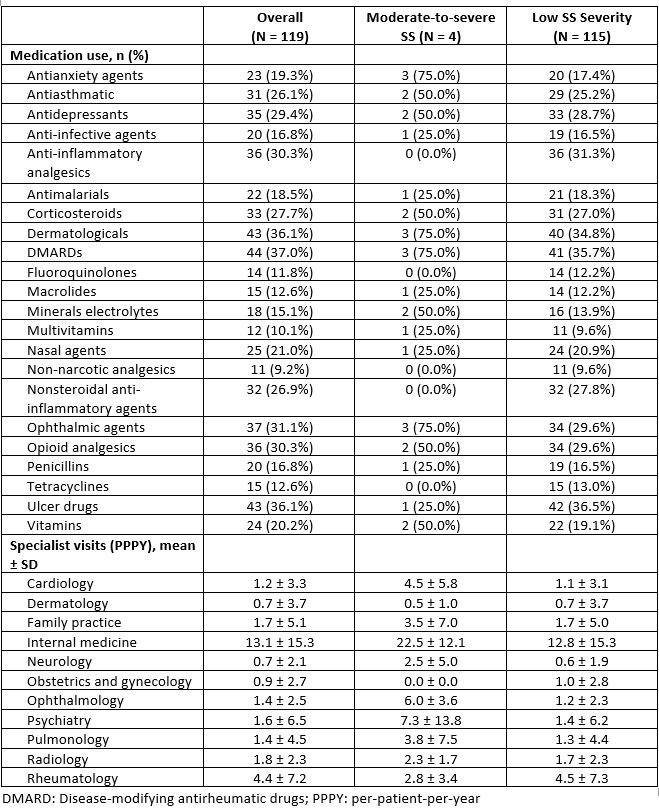Session Information
Date: Saturday, November 6, 2021
Title: Sjögren's Syndrome – Basic & Clinical Science Poster (0296–0322)
Session Type: Poster Session A
Session Time: 8:30AM-10:30AM
Background/Purpose: Sjögren’s syndrome (SS) is a chronic autoimmune disease associated with diverse phenotypes, which may include systemic disease activity. In real-world practice, the clinical presentation of SS is not well-documented. The purpose of this study was to first assess systemic domain-specific activity using the EULAR Sjögren’s Syndrome Disease Activity Index (ESSDAI), a validated composite measure of SS severity, and then to describe clinical characteristics and medication use among patients with moderate-to-severe SS and lower severity SS receiving clinical care in the United States (US).
Methods: A retrospective patient chart review was used to identify adult patients with SS receiving care at a major integrated delivery network in Massachusetts. Clinical information needed to assess ESSDAI specific-domain activity was abstracted by research nurses following a review of past rheumatologist visits among patients with SS as part of routine care. Based on the abstracted data from different domains, ESSDAI scores were computed. Patients with ESSDAI scores ≥5 were considered to have moderate-to-severe SS; while those with ESSDAI < 5 would have lower severity SS. Clinical characteristics including comorbidities, medication use, and frequency of specialist visits, were assessed using linked electronic medical records (EMR) and insurance claims 12 months prior to the rheumatologist visit.
Results: As data collection is still ongoing, data from a total of 119 patients with SS collected to date with linked EMR and claims were analyzed. The mean age of patients was 63.6 years, 92.4% were female, and 52.9% experienced SS symptoms for ≥10 years. The three ESSDAI domains with the information available most commonly were articular (85.7%), constitutional (81.5 %), and cutaneous (77.3 %), whereas the least commonly were glandular (13.5%), biological (9.2%), and renal (6.7%, Figure 1). Overall, the most commonly observed comorbidities were rheumatic disease (77.3%), pulmonary disease (28.6%), pain (21.9%), and depression (20.2%, Table 1). Polypharmacy was observed, with DMARDs (37.0%), dermatological (36.1%), and ulcer drugs (36.1%) most frequently reported (Table 2). Specialist visits for internal medicine and rheumatology were most frequently observed, with a mean of 13.1 visits and 4.4 visits per year, respectively (Table 2). Although based on the available information in patient charts, only 3.4% of patients would be classified as having moderate-to-severe SS. Among those potentially classified as having lower severity SS (i.e., ESSDAI < 5), an elevated CCI score and polypharmacy were still observed.
Conclusion: Information needed to fully and reliably assess clinical activity in ESSDAI domains was observed to be frequently incomplete in routine clinical practice, likely underestimating the true number patients with moderate-to-severe SS. A high comorbidity burden and polypharmacy were still observed among these patients, who were mostly classified with lower severity SS, suggesting possible misclassification based on incomplete information in specific ESSDAI domains.
To cite this abstract in AMA style:
Ndife B, Pivneva I, Rossi C, Signorovitch J. Assessment of EULAR Sjögren’s Syndrome Disease Activity Index (ESSDAI) Domains in Routine Clinical Practice in an Integrated Delivery Network in the United States [abstract]. Arthritis Rheumatol. 2021; 73 (suppl 9). https://acrabstracts.org/abstract/assessment-of-eular-sjogrens-syndrome-disease-activity-index-essdai-domains-in-routine-clinical-practice-in-an-integrated-delivery-network-in-the-united-states/. Accessed .« Back to ACR Convergence 2021
ACR Meeting Abstracts - https://acrabstracts.org/abstract/assessment-of-eular-sjogrens-syndrome-disease-activity-index-essdai-domains-in-routine-clinical-practice-in-an-integrated-delivery-network-in-the-united-states/



